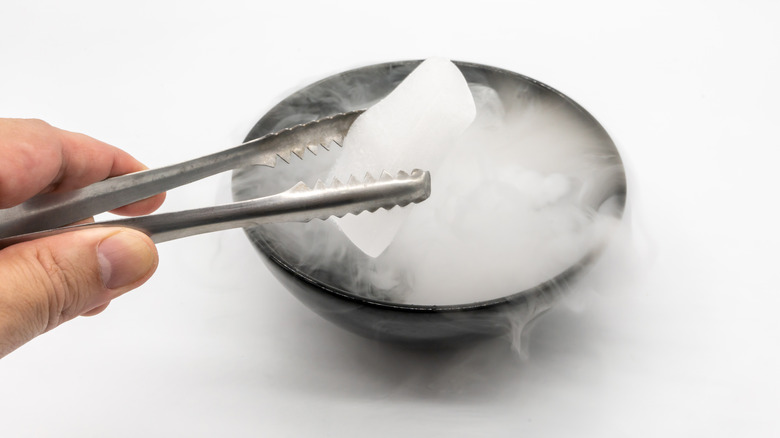How To Safely Use Dry Ice To Keep Your Frozen Treats Intact On The Go
When the weather warms, it becomes an ideal time to try your hand at making your own frozen sweet-treat recipes like honey lavender ice cream and raspberry peach pops. If you've ever made your own ice cream, you know two things: It's the perfect antidote for a steamy summer day, and it's best shared with friends and loved ones.
While it can be hard to transport your icy homemade desserts to a park picnic or friend's cookout party, it is definitely possible. In fact, it can be done effectively by using dry ice. Dry ice is actually quite different from regular ice made of frozen water, and it needs to be handled differently. Chemically, dry ice is carbon dioxide gas that has been pressurized into a solid state to form blocks. You can buy dry ice at most grocery stores, where it's usually sold, inexpensively, in 1- to 5-pound blocks.
Using dry ice is a great option for keeping your frozen treats intact — if done safely and using well-informed precautions. Most importantly, you'll want to know the material you're working with can be dangerous and even toxic if not handled properly, per the Compressed Gas Association. This makes it vital to use the right protective gear, transport and store it in well-ventilated places, and know the methods for packing and disposing of dry ice.
Practice caution when using dry ice
Although blocks of dry ice may look like regular ice, it's crucial to never consume dry ice. With a surface temperature of -109 degrees Fahrenheit, dry ice is great for freezing items quickly and keeping them very cold, but it can also cause severe burns if it comes in contact with the skin or eyes. For this reason, whenever you're handling the material, you'll need to wear heavy-duty, insulated gloves and use a tool to grab the ice. It's also a good idea to wear safety glasses or goggles and close-toed shoes. (Yes, we're talking high school chemistry class levels of preparation here.)
The condensed blocks of gas will sublimate (similar to evaporation) from a solid state back into carbon dioxide gas as they sit, so you'll need to purchase dry ice right before you use it. Also, make sure to store and transport the material in well-ventilated areas. This means, when you take dry ice home from the store or have a dry ice-packed cooler in tow, you'll need to drive with the windows open to prevent carbon dioxide from accumulating in enclosed spaces, which can be toxic.
Never store dry ice in an airtight container like the freezer. The temperature of the freezer is much warmer than dry ice and will accelerate the sublimation and build-up of carbon dioxide. That pressure will mount and, as the gas releases, it could explode or break your appliance.
How to pack dry ice for a picnic
While it takes extra effort, safety knowledge, and care, packing your cooler of homemade coconut mango ice cream with dry ice is simple, once you get the hang of things. Continue to keep spaces aired-out when working with dry ice, and use the proper safety-wear and equipment. To pack a cooler box or bag, insulate dry ice and your frozen treats by packing the ice between layers of newspaper, cardboard, or towels. If you're using a cooler, you can also leave the top cracked open to allow for a little extra air (though, most coolers are already somewhat ventilated).
By following these precautions and steps, you'll find that your icy dessert is still frozen solid and ready to enjoy, even after a bit of a journey. Once you are done with your dry ice, it's important to let it air out and sublimate away. This is best done outdoors, in a place separate from pets and kids. When the dry ice has sublimated completely (typically within less than 24 hours), you can simply recycle the packaging it was in.
Dry ice is a handy tool, if you know how to use it effectively and safely. It can also be used to ship foods all around the world. Just be sure to check with your shipper on the protocol and packaging needed to do so, and again, practice safety when preparing your package.


